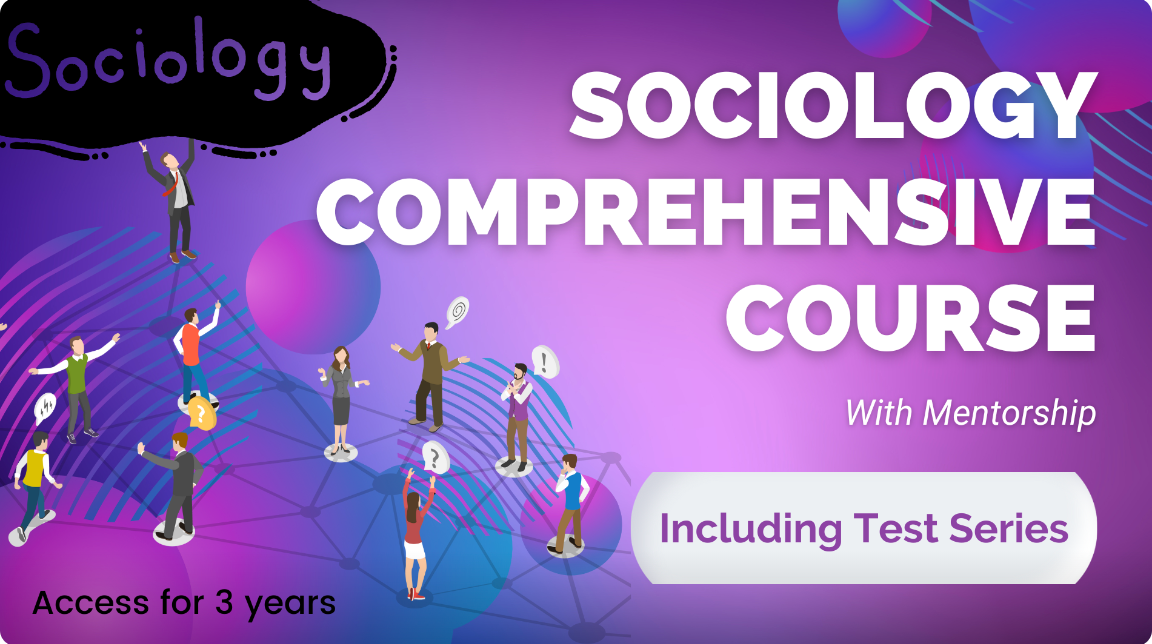Questions
- "Self and Society are twin born". Explain. (10 Marks)
- Symbolic Interactionism is all about studying the “man in society” and the “society in man.” Discuss this statement from Mead’s view. (20 Marks)
Download Model Structures PDF
Model Structures
Q1. "Self and Society are twin born". Explain. (10 Marks)
Introduction
- The sense of self is defined as a collection of beliefs that we hold, while self-socialisation is defined as a developmental process that allows you to reflect upon yourself.
- This process begins in early childhood and has many influencing factors. Some of the influences on the self socialisation process include the family, peers, teachers, and the media. Cooley's concept of the 'looking glass self', states that a person's self grows out of a person's social interactions with others.
Main Body
- The view of ourselves comes from the contemplation of personal qualities and impressions of how others perceive us.
- For Mead, the self emerges out of "special set of social relations with all the other individuals" involved in a given set of social projects.
- The self is always a reflection of specific social relations that are themselves founded on the specific mode of activity of the group in question.
- Mead identified three sequential stages that lead the child to develop a sense of self.
- These stages are play stage and game stage.
- Play Stage, in which pre-kindergarten children think and act like the people they frequently see. For example, a young girl is actively assuming the role of the mother and viewing her world as her mother does.
- In Game Stage, children between the ages of five and eight begin to take account of their own actions and the actions of others.
- As per GH mead self and society co create each other. There is an Organic link and indissoluble connection between self and society.
- Self develops as an individual (I= significant others) and then as social (me= Generalised others).
- Self is considered as a social product- self reflects the content of society- roles that are internalised as roles-identities (behavioural expectations associated with status).
- Meanings, motives and symbols are product of society.
- Socialisation is not a passive process of learning and conforming to others expectation- highly active and selective.
- Self is developed as individual grows in society and is developed through communication and interaction both by significant others and generalised others.
- According to Mead society is developed when actors adapt and adjust according to social Environment and actors interpret significant symbols and meaning. Without symbols there is no interaction and no society. So both self and society are twin born.
Conclusion
- As Mead and Cooley believe and argue "Self and Society are twin born". There is no separate and independent ego; this is simply an illusion that can't exist.
Q2. Symbolic Interactionism is all about studying the “man in society” and the “society in man.” Discuss this statement from Mead’s view. (20 Marks)
Introduction
- George Herbert Mead has made important contributions to ‘Symbolic Interactionism’ through his theory of ‘Self and Identity’. According to Mead, human thought, experience and conduct are essentially social.
Main Body
- In his famous work entitled Mind, Self and Society, Mead analyzed the formation of individual self and the historical complexity of the development of ideas from the perspective known as symbolic interaction.
- Mead was concerned with the small units of individual interaction and used the theory of the human mind, the social self, and the structures of society to explain the same.
- The Human Mind
- Human mind according to Mead is an emergent phenomenon of personal awareness on the part of the infant individual of meaningful gesture selected out of a whole range of indiscriminate physical motions.
- The human mind develops with the development of the capacity of distinguishing between nonsense motions and significant gestures of one and the others.
- The human being gradually develops his capacity to interact meaningfully to symbolic interaction by means of conventional gestures. This capacity becomes more sophisticated with the development of mind. It facilitates the development of mind, the self and society.
- The Social Self
- According to Mead, mind and society are coincidental phenomena. Mind arises within communication which is meaningful interaction.
- Communication begins in verbal and non-verbal gestures. These gestures are selected through a process of experimentation which involves significant gestures and spoken sounds. This is what he tries to co-relate to man and society.
- Self-Consciousness
- Explaining the nature of a man’s ability to take the role of the other, Mead points out “the symbol arouses in one’s self what it arouses in the other individual”.
- The mature self, he continues, arises when ‘a generalized other’ is internalized or that “the community exercises control over the conduct of its individual members”. The self’s essence is its reflective self-awareness.
- With this essential capacity, an individual can be both an object ‘me’ and a subject ‘I’ to himself. This dual capacity is the essence of being social.
According to Mead the evolution of self consciousness occurs through the following two stages.
- Play stage: It involves the child playing roles which are not his own. In this stage, a child learns by imitation – that is, by imitatively acting out the role of others – for example, the child may play at being a mother or father, a doctor or a nurse. In doing so he becomes aware that there is a difference between himself and the role that he is playing.
- Game stage: In playing a game, the child comes to see himself from the perspective of the various participants. In other words, rather than simply imitating the role of the other, the child can imaginatively place themselves in another's position and look back at themselves from the point of view of others. Thus, an individual acts and then evaluates his act from the point of view of the ‘generalized other’ or society, and accordingly makes adjustments in his behaviour.
With an awareness of self, the individual is able to see himself as others see him. When he takes the role of others, he observes himself from that standpoint and becomes aware of the views of himself that others hold.
Conclusion
- This provides the basis for cooperative action in society. The individual will become aware of what is expected of him and will tend to modify his actions accordingly.
- He will be conscious of the general attitudes of the community and judge and evaluate himself in turns of this generalized others. Thus, symbolic interactionism is all about Man in Society and Society and Man.

